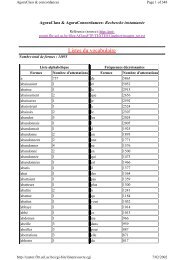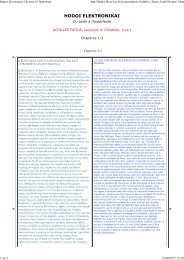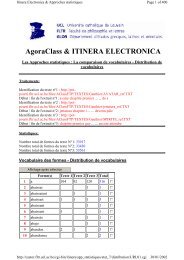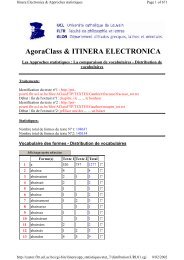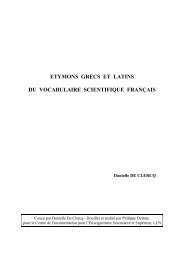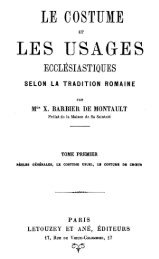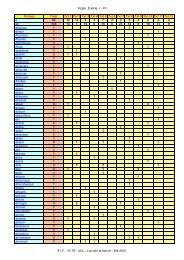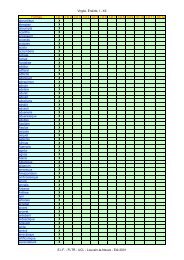The Etymologies of Isidore of Seville - Pot-pourri
The Etymologies of Isidore of Seville - Pot-pourri
The Etymologies of Isidore of Seville - Pot-pourri
You also want an ePaper? Increase the reach of your titles
YUMPU automatically turns print PDFs into web optimized ePapers that Google loves.
10 introduction<br />
History <strong>of</strong> the Vandals, although Braulio speaks <strong>of</strong> them<br />
as if they and On the Origin <strong>of</strong>theGothswere asingle<br />
work, appear to be brief but separate histories, which<br />
have been appended to the larger work. In On Illustrious<br />
Men, <strong>Isidore</strong>presents thirty-three brief biographies <strong>of</strong><br />
important Christian figures, mainly writers, from various<br />
countries (many Spaniards) and eras, including his<br />
brother Leander. It is a continuation <strong>of</strong> works with the<br />
same title by Jerome (ca. 392) and his continuator Gennadius<br />
(ca. 490); all three sketch the lives <strong>of</strong> prominent<br />
Christians, as an answer to Suetonius Tranquillus’s De<br />
Viris Illustribus. 23<br />
Like the <strong>Etymologies</strong>, theDifferences is closely concerned<br />
with the form and meaning <strong>of</strong> individual words.<br />
<strong>The</strong> first book explains the distinctions between pairs<br />
<strong>of</strong> words that are either synonyms or homophones,<br />
and gives instructions for correct usage. <strong>The</strong> second<br />
book focuses on the differences between things; between<br />
angels, demons, and men, for example.<br />
Asecondearly notice <strong>of</strong> <strong>Isidore</strong> and his works was<br />
included by Ildefonsus, bishop <strong>of</strong> Toledo, in his work<br />
On Illustrious Men, a continuation <strong>of</strong> the Jerome–<br />
Gennadius–<strong>Isidore</strong> tradition. 24 Ildefonsus was reputed<br />
to have been a student <strong>of</strong> <strong>Isidore</strong>’s; he completed the<br />
work shortly before his death in 667.<strong>The</strong>notice (cap. 8)<br />
follows:<br />
<strong>Isidore</strong> held the bishopric <strong>of</strong> the see <strong>of</strong> <strong>Seville</strong>, in the<br />
Province <strong>of</strong> Baetica, after his brother Leander. He was a<br />
man esteemed for both his propriety and his intellect. In<br />
speaking he had acquired a supply <strong>of</strong> such pleasing<br />
eloquence that his admirable richness <strong>of</strong> speech amazed<br />
his listeners. Indeed, someone who had heard a sermon<br />
<strong>of</strong> his a second time would not approve unless it were<br />
<strong>Isidore</strong> acknowledges, in the dedication (before 621) to<br />
King Sisebut prefaced to an early draft (perhaps Books<br />
I–X) <strong>of</strong> the <strong>Etymologies</strong>, that his work compiles material<br />
“gathered from my recollection (or, “record”) <strong>of</strong> readings<br />
from antiquity” (see the appended Letter VI). This is<br />
no mere topos <strong>of</strong> humility; nearly the whole work, in fact,<br />
consists <strong>of</strong> intricately woven excerpts and paraphrases <strong>of</strong><br />
the works <strong>of</strong> earlier writers. To assess <strong>Isidore</strong>’s achievement<br />
we cannot look to original researches or innovative<br />
interpretations, but rather to the ambition <strong>of</strong> the whole<br />
<strong>The</strong> sources <strong>of</strong> the <strong>Etymologies</strong><br />
repeated still further. He wrote not a few exceptional<br />
works, that is:<br />
<strong>The</strong> Types <strong>of</strong> Offices,<br />
<strong>The</strong> Book <strong>of</strong> Prefaces,<br />
<strong>The</strong> Births and Deaths <strong>of</strong> the Fathers,<br />
A book <strong>of</strong> lamentations, which he himself called the Synonyms,<br />
Two little books written for his sister Florentina, Against<br />
the Iniquity <strong>of</strong> the Jews,<br />
A book for King Sisebut, On the Nature <strong>of</strong> Things,<br />
A book <strong>of</strong> Differences,<br />
A book <strong>of</strong> Sentences.<br />
He also collected into one place from various authors what<br />
he himself called the Exposition <strong>of</strong> the Secret Sacraments.<br />
It is also known as the Questions.<br />
Finally, in response to a request from Braulio, Bishop <strong>of</strong><br />
Saragossa, his book <strong>of</strong> <strong>Etymologies</strong>. He tried to fulfill<br />
this request completely over the course <strong>of</strong> many<br />
years, and seemed to finish his final days engaged in this<br />
work.<br />
He was active during the reigns <strong>of</strong> Reccared, Liuva,<br />
Witteric, Gundemar, Sisebut, Suinthila, and Sisenand.<br />
He held the honor <strong>of</strong> the bishopric for almost forty<br />
years, and maintained the distinction <strong>of</strong> its holy<br />
doctrine, its glory as well as its propriety.<br />
Obviously a good deal <strong>of</strong> <strong>Isidore</strong>’s earlier writing was<br />
taken over into the <strong>Etymologies</strong>, which<strong>Isidore</strong> must<br />
have considered the summa <strong>of</strong> his scholarly career. Presumably<br />
he began work on it before the death <strong>of</strong> Sisebut<br />
early in 621, andheleft it unfinished at his death<br />
in 636.<br />
<strong>Isidore</strong> was <strong>of</strong>ficially canonized as a saint in 1598,and<br />
was declared a Doctor <strong>of</strong> the Church in 1722. His feast<br />
day is April 4.<br />
design, to his powers <strong>of</strong> selection and organization, and<br />
to his grand retentiveness. His aims were not novelty but<br />
23 <strong>The</strong> main part <strong>of</strong> Suetonius’s work still extant is De (Claris)<br />
Grammaticis et Rhetoribus. <strong>The</strong> Jerome and Gennadius works are<br />
edited by E. C. Richardson, Hieronymus: Liber de Viris Illustribus.<br />
Gennadius: Liber de Viris Illustribus,Texteund Untersuchungen zur<br />
Geschichte der altchristlichen Literatur 14, 1.(Leipzig, 1896). On these<br />
and <strong>Isidore</strong>’s De VirisIllustribus see R. McKitterick, <strong>The</strong> Carolingians<br />
and the Written Word (Cambridge, 1989: 200–02).<br />
24 C. C. Merino, ed. and trans. into Spanish, El ‘De Viris Illustribus’<br />
de Ildefonso de Toledo (Salamanca, 1972).





